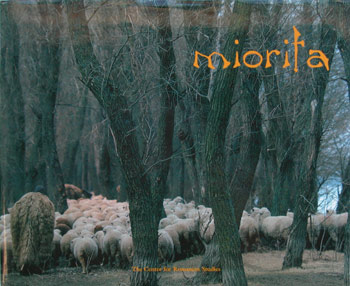
|

|
|
From the Center for Romanian Studies Edited, with an introduction by Ernest H. Latham, Jr. Essay by Alexandru Husar Photographs by Laurence Salzmann Download a PDF. This book by words and photographs illustrates and explains the central role that the ballad the Mioritza plays in Romanian culture. By combining the insights of an American and a Romanian scholar with a vision of Romanian pastoral life developed by a leading American photographer, the reader is introduced to one of the most complicated and elusive cultural icons in European civilization. It is, however, one that continues to permeate Romanian culture and offers, to those who take the time to study it, an approach to life which will resonate closely with much modern experience and understanding. This publishing event has its origins in an American pho-tographic exhibit intended for a Romanian audience in 1986 when the Ceausescu's communist regime was rejecting most American cultural offerings. The American hoped at that time to make a gesture of support and encouragement to the Romanians by this act of homage to one of their major cultural icons. In the event, the communist Council of Culture forbade the display of the exhibit which is now for the first time being made available for study. The two introductions, one by an American specialist in Romanian studies and one by a Romanian professor of Romanian literature, provide two perspectives on the Mioritza and insure that the reader will understand in the end why the ballad is central to Romanian consciousness and why it has a message of great seriousness and insight for modern man of any origin. The photographer, Laurence Salzmann, made the photographs in 1981 when he was on a fellowship in Poiana Sibiului, a small village of transhumance shepherds in the Carpathian Mountains of Romania. Dr. Ernest Latham, who conceived of the exhibit when he was the American cultural attaché in Bucharest in the 1980s, contributes an introduction which accounts his personal involvement with the Mioritza, the exhibit, and the new translation into English which was developed to caption the photographs. Prof. Alexandru Husar is a retired from the University of Iasi where he was for many years a distinguished professor of Romanian literature. He has provided an introduction which guides the reader into the deeper meaning and importance of the Mioritza. Kiki Munshi is an American foreign service officer, who in the 1980s was the director of the American Library in Bucharest and worked together with Dr. Latham on the new English translation. Date of Publication: June, 1999 Language: English approx. 96 pp., 24 x 32 cm Illustrated ISBN 973-9432-04-2 Find it on Amazon.com |
|
|
|
|
||
|
|
|
|
|
|
||